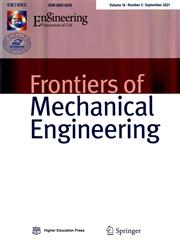选择性激光熔化熔池现场监测的协同控制
IF 4
2区 工程技术
Q1 ENGINEERING, MECHANICAL
引用次数: 0
摘要
选择性激光熔化(SLM)过程中的原位监测是一种很有前途的解决方案,可以减少缺陷并提高竣工零件的质量。然而,现有的监控平台缺乏对过程监控组件的协同控制,因此无法在整个打印过程中实现近距离、多角度的实时准确信号采集。在本文中,由多个电机驱动,构建了一个离轴监测平台,该平台能够与刮刀和激光束一起移动。提出了一种基于模糊控制的速度优化方法,以避免对CMOS相机成像质量的冲击影响以及刮刀与激光的碰撞。熔池的当前位置和目标位置之间的误差被用作模糊控制器的输入。然后,对步进电机的PI控制器的参数进行动态调整。通过ADAMS和SIMULINK联合仿真验证了模糊算法的可行性。最后,进行了协同运动实验和各模块的响应。结果表明,使用所提出的协同平台,系统的响应速度提高了约49.6%,电机的初始速度降低了约12.6%,从而避免了电机的过度加速。每台电机的响应时间提前约31.8%,满足SLM过程监测的运动响应要求。本文章由计算机程序翻译,如有差异,请以英文原文为准。
Collaborative control for in situ monitoring of molten pool in selective laser melting
In situ monitoring during the selective laser melting (SLM) process is a promising solution to mitigate defects and improve the quality of as-built parts. However, the existing monitoring platform lacks collaborative control of the process monitoring components, and as a result, it cannot realize a real-time and accurate signal acquisition at a close distance and multiple angles during the whole printing process. In this paper, driven by multiple motors, an off-axis monitoring platform is constructed that enables movement in conjunction with the scraper and laser beam. A fuzzy control-based velocity optimization is proposed to avoid the shock effect on the imaging quality of the CMOS camera and the collision of the scraper and laser. The error between the current location and target location of the molten pool is utilized as the input of the fuzzy controller. Then, the parameters of the PI controller of the stepping motor are dynamically adjusted. ADAMS and SIMULINK co-simulation are conducted to verify the feasibility of the fuzzy algorithm. Finally, the experiment of collaborative motion and the responses of each module are conducted. The results show that with the proposed collaborative platform, the response speed of the system is improved by about 49.6%, and the initial speed of the motor is decreased by about 12.6%, thus avoiding excessive acceleration of the motor. The response time of each motor is ahead of schedule by about 31.8%, which meets the requirements of motion response for SLM process monitoring.
求助全文
通过发布文献求助,成功后即可免费获取论文全文。
去求助
来源期刊

Frontiers of Mechanical Engineering
Engineering-Mechanical Engineering
CiteScore
7.20
自引率
6.70%
发文量
731
期刊介绍:
Frontiers of Mechanical Engineering is an international peer-reviewed academic journal sponsored by the Ministry of Education of China. The journal seeks to provide a forum for a broad blend of high-quality academic papers in order to promote rapid communication and exchange between researchers, scientists, and engineers in the field of mechanical engineering. The journal publishes original research articles, review articles and feature articles.
 求助内容:
求助内容: 应助结果提醒方式:
应助结果提醒方式:


